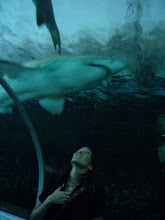An interview I did with C21 a while go finally got shaped into an article. Yay!
read AETN’s ABC of social media @ c21media
AETN’s ABC of social media
RE-vision 2009: Rather than sit back and watch audiences flock away from the television set and on to the net, AETN International has embraced social media. Director of digital media Fabienne Fourquet (below) tells Katie Jacobs how.
Last autumn, US cable company A&E Television Networks (AETN) launched a game on Facebook based on its factual series Parking Wars, about the men and women of the Philadelphia Parking Authority.
The game, in which each player owns a street corner and can ticket their friends' cars and become a Parking Mogul, was the only marketing support behind the first season's launch.
AETN International director of digital media Fabienne Fourquet claims it was one of the most successful branded applications on Facebook, earning more than 1.2 million unique players, with 200,000 users playing and 100,000 tickets distributed every day.
On TV, she says, Parking Wars outperformed A&E's network average, was ranked seventh in its time slot out of all US cable networks among adults aged 18-49, and delivered a demo seven years younger than the network's average.
All of which was enough to convince the company of the value of the need to adopt "sensible and smart approach" to social media. AETN now has Facebook fan pages for its channels, such as History, plus specific programme brands like Paranormal State, and all can be followed on Twitter.
It can take a lot of time and effort to develop a strong presence in these spheres because, as Fourquet says, "a good social media strategy takes into account the fact that social networks are an earned media and not a paid one."
What this means is engaging the audience through games, blogs, forums and communities rather than bombarding them with ads. But using social media is essential for a traditional TV networks' survival, Fourquet believes. Programme choices on any medium - TV, online, mobile - are increasingly made through recommendations from the likes of Facebook, MySpace, Bebo and others, she says.
"More and more TV content is consumed through social media recommendations that don't answer to traditional marketing tactics or paid media promotion. So the success of TV series and channels will depend upon a good social media strategy and approach," she explains.
Fourquet defines social media as the crossroads of social networking and media consumption. She quotes statistics that show two-thirds of the global online population is on a social network currently, and media consumption is continuing to rise - over 150 hours of video watched per person each month in the US alone.
"If you add to these numbers the growing trend of viewers watching TV and using the web simultaneously - Nielsen calls this 'mutually reinforcing media' - you begin to understand the opportunities and to see that more and more media is becoming 'social' in the sense that viewers are emailing, IM-ing or Twittering friends on a PC or mobile device while consuming video."
Not only are these forces shaping the way in which people consume TV content, they're also going to have an impact on the nature of that content. "Social elements such as rating and commenting about shows will become an integral part of the viewing experience. In the future users and fans will have more of a say in TV and social media brands' activities," Fourquet predicts.
But with even more new talent and content emerging online, can TV and social networks co-exist? Absolutely, she says, they already do: "The two mediums enhance one another's experience."
Discussing TV and creating communities online may facilitate the return of watching together: "We've seen it happen in the past year with the US elections and the Olympics."
Delayed watching is also a growing trend, and viral watching - commenting on and communicating about shows while watching them - is on the increase. This viral interaction is definitely something that producers and broadcasters should capitalise on, according to Fourquet.
"They should use social media as awareness and promotional tools to extend their brand and reach more eyeballs," she says. "It should also be used as a test bed or incubator for new programming ideas. Social media sites are a great way to target niche audiences and develop new content."
The economic meltdown means people are spending more time online or watching TV, so social media may become an indispensable part of media consumption. This, in turn, should lead to increased advertising revenue, but social networks are still struggling to crack this one.
"With social and media activity growing, advertisers will have to turn to these growing audiences and find the magic bullet to grab their attention," says Fourquet.
But this is something that hasn't happened yet. Simplifying and finding common ad formats, educating publishers, advertisers and ad agencies about the possibilities and advantages of the different platforms and connecting with viewers are some of the issues she says need to be resolved. Measurement and research tools that help demonstrate and aggregate digital campaign ROI across all sites, services and media are also developments she would like to see.
These remain more than minor kinks to be ironed out before the ecosystem becomes ideal for all parties, but Fourquet believes that ultimately video content will become "a more seamlessly integrated experience to our favourite social networks, the way music has become an integral part of MySpace."
Katie Jacobs
30 Apr 2009
© C21 Media 2009
Droits licences et usage commercial du logo Facebook
-
Le débat autour des droits licences et usage commercial du logo Facebook ne
cesse de s’intensifier à mesure que la plateforme s’impose dans
l’écosystème ...
3 hours ago




No comments:
Post a Comment